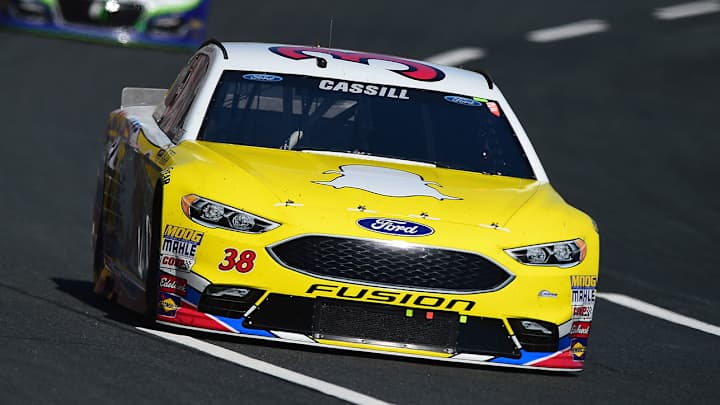NASCAR pivots on social media & finds success

Read about the latest sports tech news, innovations, ideas and products that impact players, fans and the sports industry at SportTechie.com.
CHARLOTTE, N.C. — The message to Scott Warfield 2½ years ago was fairly simple.
“We’re going to grow via social media,” NASCAR CEO Brian France told his social media director.
After NASCAR regained control of its digital and social rights from Turner Sports in 2013, the shift away from massive marketing campaigns around 30-second TV spots had begun.
“We flipped the way we’ve gone about marketing,” said Warfield, who added that NASCAR was playing social catch-up but has since narrowed the gap compared when looking at its competitors. “Facebook, Instagram, Snapchat—it’s where we can cultivate that next-generation fan.”

Subscribe to the
SportTechie Newsletter
- Check out the new Seth Davis Podcast
- Ronaldinho backing new social video app
- NBA players make 'mind-blowing' visit to Google
NASCAR monitors and strategically tracks 750 social accounts along with a few thousand keywords around the property, tracks, teams, industry partners, brands and other racing tie-ins. Traditional platforms like Facebook, Twitter and Instagram are analyzed while ancillary ones such as Tumblr, Reddit and YouTube are also accounted for.
A mid-week report is compiled after every race weekend to see where spikes in the online conversation occurred, level of sentiment around the sport, how marketing campaigns are performing and other pertinent information. The findings are then shipped off to the appropriate business units for evaluation, with the social media group participating in the weekly exercise, too.
The social team now includes about a dozen staffers, with its bandwidth allowing the sports property to keep pace with the sport on race days.
“We have made an intentional effort to be much more real time in our content as well,” said Sean Doherty, director of digital and social media engagement. “We see something that fans are excited about, we can cut that content and get it out within minutes. It’s about capturing the essence of that moment with a goal of increasing the exposure of our content and hopefully getting more people to consume NASCAR content.”
Added Warfield: “We see [social media] as a fan growth tool. Yeah, we’re going to monetize it, but that won’t be the No. 1 priority. The No. 1 priority will be to speak to audiences where they are, when they’re there and optimize the content to work for that platform.”
During every Sprint Cup race, a social strategist, video producer and creative designer operate from a Charlotte social media war room, operating in conjunction with members of the social team on site. Together, they produce content, churn out GIFs, cut Vines and create easily digestible graphics, with a main objective of being as in-the-moment as possible in their execution and content delivery.
When it comes to selecting a go-to social platform for NASCAR, which has seen its social audience increase by 15% from 2015, Warfield says each has its perks and drawbacks.
Over the summer, 22-year-old driver Ryan Blaney took over NASCAR’s Snapchat account for three days to give fans a behind-the-scenes peak at his vacation to Costa Rica. The social channel and NASCAR also inked a partnership for four Live Stories in 2016 along with Landon Cassill’s Snapchat-wrapped car during the Bank of America 500 this past October. It’s the platform that has had the largest year-over-year social growth, at over 90%.
Oh snap. It's time for practice. pic.twitter.com/rJdvogmeQH
— Front Row Motorsports (@Team_FRM) October 6, 2016
Warfield added that beyond Snapchat, Twitter, Facebook and Instagram have played integral roles in NASCAR’s rise across social, especially video.
With 171 million social videos to date, NASCAR has seen a 340% year-over-year growth rate.
“As we’ve gone more native on Facebook, the numbers are insane,” Warfield said. “Man, I can do a ton of views in real time and drive tune-in to a live broadcast.”
Around the 2016 Chase for the NASCAR Sprint Cup this Fall, drivers’ Twitter handles replaced actual names on their car windshields, akin to an NFL or NBA player swapping out his last name for his handle on the back of a jersey.
“I think it shows the level of connection social has across the industry,” said Warfield.
While NASCAR hasn’t ventured too far down the live-streaming route compared to the likes of NBA teams, the NFL, media entities or college athletics, it is placing an emphasis elsewhere . . . for now. For example, Twitter Q&As have proven to be a valuable fan engagement tool, whether on the platform itself or via Periscope. Even at the midnight hour, Dale Earnhardt, Jr. has taken the reigns on back-and-forth exchanges with fans on Twitter.
"Hey everybody! @joeylogano signing in ready to answer your questions!" #AskLogano pic.twitter.com/ETuKVmGMpC
— NASCAR (@NASCAR) November 14, 2016
Warfield said he and his staff work with drivers individually to offer best practices, answer questions and provide general social guidance, sometimes even letting drivers “dabble on NASCAR’s own platforms” to get a feel for what they like or dislike before establishing one or two accounts. For the most part, drivers have been receptive to social as the property looks to establish an even bigger footprint online.
“Run with it, crush it, be great there,” Warfield said of drivers migrating to social channels. “Everyone understands the importance of what we’re trying to do here.”
